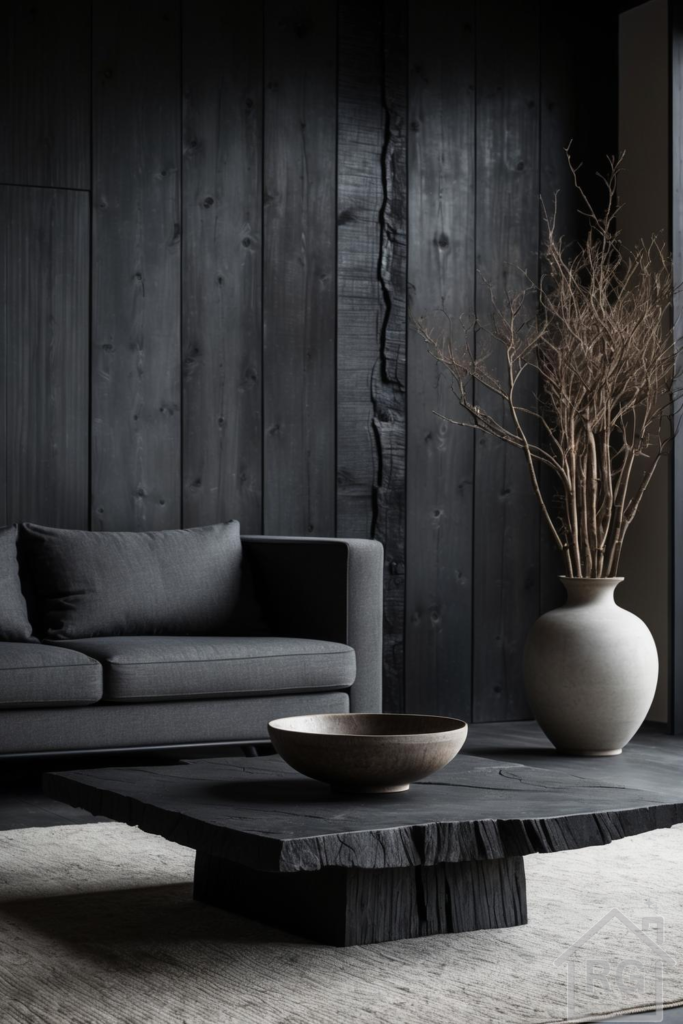
In the bustling rhythm of modern life, our homes often serve as a much-needed refuge. For those seeking a deeper sense of calm, connection, and authenticity, the fusion of Japandi and Wabi Sabi aesthetics offers a profound design philosophy. This unique blend, exemplified by the serene living room pictured, marries the sleek functionality of Scandinavian design with the rustic, imperfect beauty of Japanese Wabi Sabi. It’s not just about decorating; it’s about creating a sanctuary that celebrates natural materials, muted palettes, and the quiet elegance of imperfection.
The Harmonious Palette: Deep Tones and Earthy Whispers
The first striking element of this design is its masterful use of color. Far from being stark, the dominant dark tones—a rich, deep charcoal or near-black on the walls, reminiscent of traditional Shou Sugi Ban charred wood—create an enveloping sense of intimacy and depth. This isn’t a color that recedes; it embraces, providing a dramatic yet grounding backdrop for the entire space. Imagine the feeling of stepping into a room where the walls themselves seem to absorb the day’s anxieties, leaving only a profound sense of peace.
Against this dark canvas, a soft, muted gray sofa offers a gentle contrast, its inviting fabric promising comfort. This mid-tone gray acts as a bridge, softening the intensity of the dark walls while maintaining the overall subdued mood. It’s a color that speaks of quiet sophistication, allowing other elements to subtly emerge.
Accents are introduced through the natural world: the large, earthy beige ceramic vase, its surface subtly textured, and the smaller, warm brown decorative bowl. These pieces introduce the organic, unrefined beauty of natural clay and stone, their colors echoing the very earth from which they came. The dried, natural branches, with their delicate, almost skeletal forms and varying shades of light brown, add a touch of ephemeral beauty, reminding us of nature’s cycles. Even the area rug, a light, almost off-white gray, provides a soft landing, its subtle texture adding another layer of visual interest without overwhelming the senses. Together, these colors create a symphony of understated elegance, where every hue contributes to a feeling of grounded tranquility.
A Symphony of Textures: The Tactile Experience
Beyond color, the Japandi Wabi Sabi aesthetic thrives on texture. This room is a masterclass in tactile richness, inviting touch and exploration. The most prominent texture is the charred wood paneling on the wall, often known as Shou Sugi Ban. This isn’t merely painted wood; it’s wood that has been intentionally treated, its surface bearing the marks of fire, creating a deeply textured, almost sculptural quality. The grain is pronounced, the knots visible, and the occasional deep crack or fissure tells a story of natural transformation. Running a hand across such a surface would reveal its unique character, a testament to the beauty of imperfection.
The sofa, likely upholstered in a durable natural fiber like linen, cotton, or hemp, offers a different kind of tactile pleasure. Its soft, slightly coarse weave provides a comforting contrast to the hard, raw wood. It’s a fabric that invites you to sink in, to relax, and to feel truly at ease.
The coffee table is another textural marvel. Crafted from what appears to be a solid, raw slab of dark wood, often with live edges, its surface bearing natural cracks and imperfections. This isn’t polished perfection; it’s the beauty of the material in its most authentic state. The weight and solidity of the table ground the space, a powerful anchor in the room.
The ceramic pieces—the large floor vase and the decorative bowl—add yet another layer of texture. Their matte, unglazed surfaces reveal the subtle irregularities of handmade pottery, perhaps with tiny air bubbles or variations in color that speak of their artisanal origins. The dried branches, with their intricate network of twigs, offer a delicate, almost brittle texture, a stark yet beautiful contrast to the solidity of the wood and ceramic.
Finally, the woven area rug underfoot provides a soft, inviting texture, its subtle pattern adding visual depth without distracting from the overall minimalist feel. Each texture in this room is carefully chosen to evoke a sense of natural authenticity, creating a multi-sensory experience that is both grounding and deeply satisfying.
Curated Simplicity: Furniture and Decor as Art
In a Japandi Wabi Sabi space, every object is chosen with intention, reflecting a philosophy of ‘less is more.’ The furniture is minimalist, functional, and built to last, emphasizing quality over quantity. The sofa, with its clean lines and low profile, embodies Scandinavian efficiency, while its muted color and natural fabric align with the Wabi Sabi appreciation for organic materials.
The coffee table is a focal point, not just a piece of furniture, but a sculptural element. Its raw, dark wood construction, with visible grain and natural imperfections, celebrates the inherent beauty of the material. It’s a piece that tells a story, inviting contemplation rather than just serving a purpose.
Decor is sparse but impactful. The large floor vase, with its simple, organic form, holds a collection of dried branches. These aren’t vibrant flowers, but rather elements that speak of life’s cycles, of quiet endurance and natural beauty. They introduce an organic, sculptural element that is both striking and understated. The small decorative bowl on the coffee table, perhaps a hand-thrown ceramic piece, adds another touch of artisanal charm, its subtle imperfections adding character.
There are no superfluous items, no clutter. Each piece serves a purpose, whether functional or aesthetic, and contributes to the overall sense of calm and order. This intentional curation allows each object to breathe, to be appreciated for its individual beauty and its contribution to the harmonious whole.
Creating the Mood: Serenity and Mindfulness
The overall mood of this room is one of profound serenity and mindfulness. It’s a space designed for quiet contemplation, for unwinding after a long day, and for reconnecting with oneself. The subdued lighting, likely ambient and indirect, enhances this feeling, casting soft shadows that highlight the textures and forms within the room.
The Wabi Sabi influence encourages an appreciation for the imperfect, the transient, and the authentic. The visible cracks in the wood, the subtle variations in the ceramic, the dried branches—these are not flaws to be hidden, but rather marks of character and history. They remind us that beauty can be found in the natural wear and tear of time, in the unpolished and the unpretentious.
This room invites you to slow down, to notice the subtle details, to feel the textures, and to simply be. It’s a space that fosters a sense of groundedness and peace, a true sanctuary from the outside world.
Tips for Achieving This Look in Your Own Home
Inspired by this tranquil space? Infusing your own living room with the essence of Japandi and Wabi Sabi is achievable by focusing on these key principles:
- Embrace a Muted Palette: Start with a base of deep charcoals, soft grays, and warm off-whites. Introduce earthy tones through natural materials like wood, clay, and stone. Avoid bright, saturated colors.
- Prioritize Natural Materials: Think raw wood (especially charred or reclaimed), linen, cotton, wool, ceramic, stone, and natural fibers like jute or rattan. The more natural and unprocessed, the better.
- Celebrate Imperfection: Seek out handmade items with slight irregularities. A ceramic vase with an uneven glaze, a wooden table with visible knots or cracks, or textiles with a natural, slightly rumpled look all contribute to the Wabi Sabi charm.
- Opt for Minimalist Furniture: Choose pieces with clean lines, simple forms, and a low profile. Focus on functionality and comfort. Quality over quantity is key.
- Curate Your Decor: Be selective with your accessories. Each item should have a purpose or a story. Think sculptural dried botanicals, simple ceramic bowls, or a single, meaningful piece of art. Avoid clutter at all costs.
- Incorporate Organic Forms: Look for objects with natural, flowing shapes rather than rigid, geometric ones. This could be a free-form bowl or a vase with an organic silhouette.
- Layer Textures: Even within a monochromatic scheme, texture is vital for adding depth and interest. Combine smooth fabrics with rough wood, matte ceramics with woven rugs.
- Mindful Lighting: Favor soft, ambient lighting. Natural light is paramount, so keep windows minimally dressed. Consider dimmable lights and warm-toned bulbs to create a cozy, inviting glow in the evenings.
- Connect with Nature: Bring in natural elements. Dried branches, a single potted plant, or even a bowl of smooth river stones can ground the space and foster a connection to the outdoors.
- Embrace Emptiness: Allow for negative space. Not every surface needs to be filled. Empty spaces can be just as powerful as filled ones, allowing the eye to rest and the mind to calm.
Conclusion: A Lifestyle, Not Just a Look
The Japandi Wabi Sabi living room is more than just a design trend; it’s an invitation to a more mindful way of living. It encourages us to find beauty in simplicity, to appreciate the natural world, and to embrace the authentic, imperfect nature of existence. By carefully selecting materials, colors, and objects that resonate with these principles, you can transform your living space into a true sanctuary—a place where serenity reigns and every imperfection tells a beautiful story. Begin your journey to a more peaceful home today.
